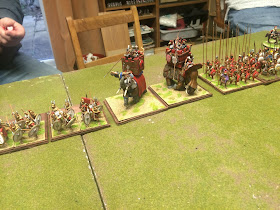Both sides were roughly equal in size but different in character. The Romans field mostly Hastai/Principes supported by Latin allies and some cavalry. Pyrrhus had a mixture of pikemen of various qualities and crucially a small force of elephants.
Pyrrus deployed with massed pike phalanxes on his left and the weaker Greek allies mostly on the right. The left flank was occupied the heavy cavalry with skirmisher support and the right by elephants with peltasts in attendance. A cavalry attack on the left looked the main effort.
 |
| Pyrrhic left |
 |
| S-pikey centre |
 |
| Elephants and support |
The Romans opted for a less balanced deployment. The left (opposite the elephants) contained the cavalry, light heavy Spanish, and a unit of Triarii - plenty of manoeuvrable units. The centre was a solid mass of Romans / Latins and the left had two more Triarii, offering both offensive or defensive options.
 |
| Roman left |
 |
| Solid centre |
 |
| Triarii in the distance |
 |
| Close-up of the pikes |
The opening action was on the Pyrrhic left as he sought to protect his elephants from the pesky Spanish LHI, whilst advancing several units of Greek allies to close-down the Roman's space.
 |
| Peltasts move to cover the elephants |
 |
| Romans advance |
The Spanish forged ahead and were able to cut through the Peltasts with aid from some ~roman heavy cavalry. With the elephants under threat a pike unit intervened to try and slow the Roman advance.
 |
| LHI try to reach the elephants |
 |
| Some tricky manoeuvring |
On the Roman right the successor cavalry advanced rapidly forcing the Triarii to deploy into blocking positions to protect the flanks of the Roman main lines. This met with mixed results - the Greeks were easily repelled but two high-rolling rounds saw the Companions dispatch one of the Romans.
 |
| Triarii cover the flanks |
 |
| Things go badly for the Roman veterans |
 |
| The Companions are victorious |
The mainline clashed in the centre in a classic pilum vs pike encounter, with things pretty even in the first few rounds. In a bold move the Romans through their light cavalry into a Greek unit attempting to turn the right flank. This did not receive the luck it deserved, but did delay the attack for three precious turns.
 |
| Clash of the lines |
 |
| Cavalry thwart a flank attack |
Over on their left the Romans had some success against the weaker Greek allies but were unable to exploit this rapidly enough to roll-up the Successors flank. The Romans also suffered as they lost a unit of heavy cavalry to the elephants.
 |
| Greek allies crumble |
 |
| Romans grind forward but all too late to win |
In the end time ran out for the Romans as their right crumbled under a combined assault from the Companions and a unit of Greeks.
 |
| Heavy going in the middle |
A close battle but a win for Pyrrhus by 7-4. It was closer than that makes it seem, but the Romans had a couple of poor combat rounds at just the wrong time and so failed to destroy some of the wavering phalanx. Perhaps the deciding factor though was that the Roman horse was delayed much longer by the elephants than the Companions were by the Triarii and sol had no meaningful impact on the battle.
 |
| Pyrrhus secret weapon |
Two comments: Firstly the Greeks were very lucky to get their more ordinary cavalry to break off from the triarii on the Pyrrhic left and go back 12 inches as this gave them two moves to remove casualties before the triarri could come up with them. Secondly the Greeks did well in using their SI bows abd javelin light cavalry to put casualties on the Roman cavalry which meant that the Romans only had to lose one casualty to be removed.
ReplyDelete